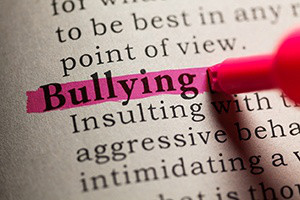 As adults, we tend to think of bullying as something we may need to protect our children from. However, bullying isn’t limited to children. Unfortunately, instances of adult bullying are on the rise.
As adults, we tend to think of bullying as something we may need to protect our children from. However, bullying isn’t limited to children. Unfortunately, instances of adult bullying are on the rise.
Over 25% of adults admit to having been the victim of bullying as an adult. The most predominant environment in which adult bullying occurs? The workplace.
What Is Workplace Bullying?
The definition of bullying for adults is really no different than the definition of bullying in children. It is various types of abuse repeatedly aimed at an individual or group of persons by another person or group.
Adults are more likely to use verbal bullying as opposed to physical bullying. The goal of an adult bully is to gain power over another person and make him or herself the dominant adult. They often try to humiliate victims and show them who is in charge. While they may be in a true power position in the organization, they don’t necessarily have to be in order to be considered a bully.
What Are The Habits Of Bullies?
Some habits of bullies tend to portray include the following. It is important to understand these habits so you can notice the behaviors in your workplace and try to stop them before they get worse.
- Political backstabbing - we are all familiar with office politics – strategies people play to gain advantage in the workplace. This often has a negative connotation and rightfully so, as often those strategies involve seeking advantage through underhanded means at the expense of others.
- Social undermining is the expression of negative emotions directed towards a particular person or negative evaluations of the person as a way to prevent the individual from achieving his or her goals. The behavior of the perpetrator is often due to feelings such as anger or dislike towards the target. This behavior is only considered social undermining if the perpetrator’s action is intended to harm or hinder the target.
- Public belittling is a way of making someone else seem less important than yourself. Bullies will go out of their way to point out what they perceive as inferior qualities in their target.
- Ostracism is excluding one from social acceptance, privileges, friendship, etc. Generally, we spend 40 hours or more per week with our co-workers. Most of us assume we will make social connections in the workplace, but in this case, a bully goes out of his or her way to be sure to exclude an individual or individuals.
- Hazing is the practice of rituals, challenges, and other activities involving harassment, abuse, or humiliation to initiate a person into a group. Most of us probably think of hazing in the context of fraternities and sororities; however, hazing happens in work environments as well, should be watched for and stopped immediately.
What Are The Types Of Bullies?
Types of bullies include people who are:
- The conceited or narcissistic adult bully is self-centered and does not share empathy with others. There is little anxiety about consequences and this type of bully has to put others down in order to feel good about him or herself.
- Imprudent or impulsive adult bullies are more spontaneous with their behavior and actions. Even if the bully is aware of consequences to his or her actions, this bully has a hard time restraining the bullying behavior. In some cases, the bully may not even intend to target a victim, but may be lashing out due to his or her own stress that has no relation to the victim.
- The somatic or physical bully may use the threat of harm or physical domination. Adult bullying rarely turns to physical confrontations, these bullies will use their physicality to intimidate their target and may resort to stealing or damaging the victim’s property rather than confronting their target.
- Verbal adult bullies may start rumors about the victim or use sarcastic or demeaning language to dominate or humiliate. This is one of the most difficult types of bullying to document as the bully can play innocent and allege to simply have been misunderstood.
- The ancillary or secondary adult bully is someone who does not initiate the bullying themselves, but will join in and/or agree with the actual bully to try to prevent themselves from becoming the bully’s next victim. These types of bullies may feel bad about participating, but are more concerned about protecting themselves rather than standing up for the victim.
There is a strong link between bullying and violence. Studies show that both victims of, and bullies themselves, are more likely to engage in violent behavior. While we have focused on the traits of adult bullies, remember, they didn’t wake up one day and become a bully. Bullying is a learned behavior and can be linked to severe physical punishments used at home, lack of parental involvement, and a lack of knowledge about positive ways to deal with problems.
Taking time to understand what a bully is and what it looks like in the workplace is the first step in prevention and keeping your workplace safe.



